
Prior to the middle of the 19th Century the area we now know as Somerstown was largely an open space known as St Peters Park, but pressure to build houses on this land was growing. During the twenty years after the Napoleonic Wars the area around Queens Terrace and Kent Road in Southsea was being developed whilst terraces were being built South of Rivers Street under the name of Allens Town. The fragmentary nature of the development was mainly because of the haphazard system of land ownership. New through roads could not be constructed so access to any new developments could only be by way of existing public rights of way. Somers Road was just such a way which as early as 1810 linked Fratton with Old Portsmouth.
The Southsea area was intended primarily for naval officers and was heavily influenced by the work of Thomas Owen. As the Navy reached a peak in the latter half of the 19C there came a great need for housing for the bigger labour force required. And so Fratton spread South and Southsea spread North. The major church of the time was St Judes on Kent Road, designed and built by Thomas Owen, but by 1851 it was serving a parish of 11,000 souls which it could not accommodate.
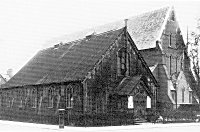
In 1871 the Church Council decided to erect a temporary church for the poorer classes. A plot of land had been reserved by it's owner, Mr J Godman Temple who was selling St Peter's Park, to be given free for the construction of a church. It was to this site, or close to it, that the Iron Church was built.
It was purchased, erected, furnished, decorated etc for the sum of £789. It seated 350 people but very soon even this was not enough and by 1879 a committee was formed to oversee the raising of funds for a new permanent church. This was considered urgent "...because of the possibility of the nonconformists beginning to build if the neighbourhood were left unoccupied". By July 1881, some £5500 had been pledged and an agreement was reached with the Architect, Mr Hudson of Kent Road, to erect the church in no more than one year.
Meanwhile, with the development of St Peters Park proceeding rapidly, it was realised that the Iron Church had been placed too far North of its allocated spot - in what is now Fraser Road. Eventually it was moved on rollers to it's correct position on land that is now occupied by St Peters Church Hall, and there it stood until 1923.
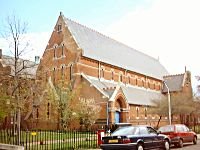
On 20th May 1882, the foundation stone for the new church was laid, and true to his promise Mr Hudson had it built and ready for opening on 20th May 1883. Shortly after, the church was consecrated and the new parish of St Peter the Apostle was formed. This parish was bounded by Elm Grove to the South, Victoria Road to the East, Bailey's Lane/Broad Street in the North and the course of the 'Ham Brook' in the West.
[Article based on the St Peter's Centenary booklet published by Mr AA Smith in 1983]
For details of the memorials in St Peter's please see our Memorials in Portsmouth site.
St. Peter's Church Lads' Brigade
Major Hamilton de la Poer Beresford led a brigade of the Church Lads' Brigade, centred on St. Michael's Church. He and his lads were quite happy and content there, but by 1905 the Vicar of St. Michael's had become less enchanted and suggested they might like to seek some other centre of operations. Three churches offered to receive them - St. Luke's, St. Paul's and St. Peter's. After consultation and inspection the Major chose St. Peter's and thus was born St. Peter's Church Lad's Brigade. The following Sunday he, with Mr "Curly" Robertson and one hundred lads occupied the pews in the south aisle. This position was to be occupied by the Church Lads' Brigade until the outbreak of the
Second World War.
In 1907 Major Beresford bought a large plot (39, 41 and 43) in Somers Road, about 100 yards south of the church, opposite the end of Hudson Road. There he built a chapel - St. Alban's Chapel - and a drill hall. These, together with the house already occupying part of the site, became the headquarters of the Brigade, which was very much alive and active until 1939. Every Sunday all three buildings were occupied by Sunday Schools, Bible Classes and discussion groups.
In 1917, the Major drew up a Trust Fund "... for the benefit of lads and young men connected with the St. Peter's Church, as the Vicar of St. Peter's for the time being may determine".
On the outbreak of war in September 1939, many of the children of the area were evacuated. The more mature members of the Brigade joined the Services and the rapid decrease in members and leaders meant that the Brigade was mothballed for the duration.
After the war, the Brigade was resurrected, but never again enjoyed the popularity of former years. In 1959 its headquarters were demolished and the Church Lads' Brigade stood down.
There are two photographs of the Lads' Brigade at camp in 1895 and 1931.
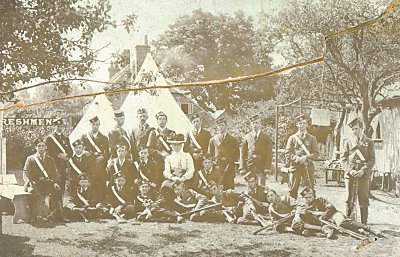
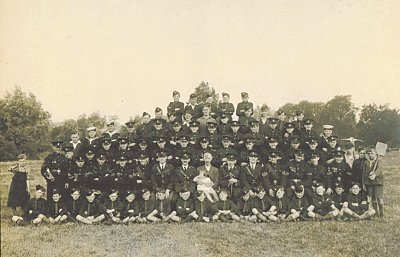
A photo of the inside of St. Alban's Chapel
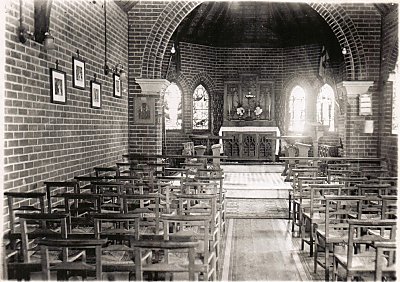
After the closure of the chapel, the reredos from behind the altar, was incorporated into a bookcase/altar, which now stands in the south aisle of St. Peter's church. The wooden lectern and some of the wooden chairs were also moved to St. Peter's Church.
Information about the Lads' Brigade from by April Gooch and Jimmy Smith